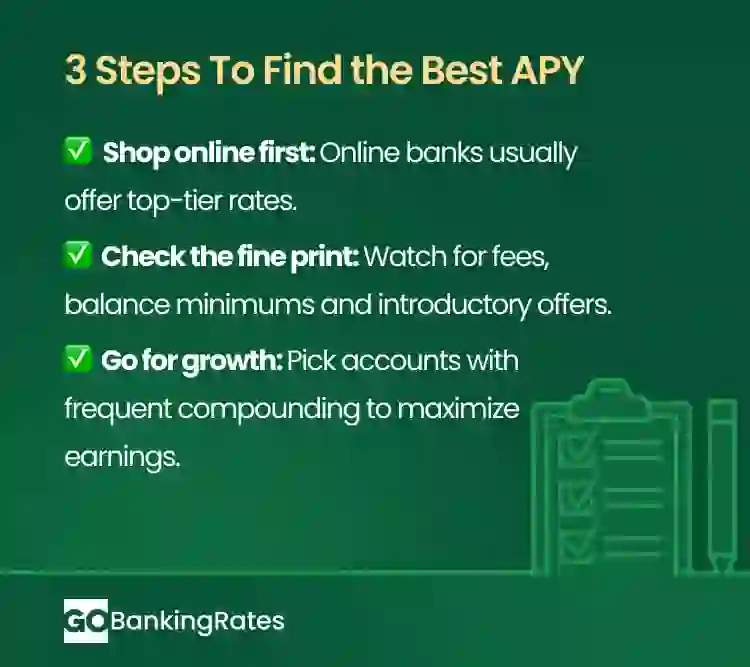What Is APY and How Does It Work?

Commitment to Our Readers
GOBankingRates' editorial team is committed to bringing you unbiased reviews and information. We use data-driven methodologies to evaluate financial products and services - our reviews and ratings are not influenced by advertisers. You can read more about our editorial guidelines and our products and services review methodology.

20 Years
Helping You Live Richer

Reviewed
by Experts

Trusted by
Millions of Readers
Ever wonder how much your money really earns just by sitting in the bank? That’s where annual percentage yield (APY) comes in. APY shows how much interest your money can earn in a year — and the higher it is, the faster your balance grows. Here’s a breakdown of how APY works and how it can help your savings go further.
What Is APY?
APY measures how much interest you’ll earn on an investment or savings account over one year. Here are some key features to know:
- Compounding interest: APY includes the effects of compounding, meaning you earn interest on both your original balance and the interest it’s already earned.
- Variable or fixed: Your APY can change over time or stay the same for the term.
- Not always guaranteed: If your account has a variable rate, then the bank can change the APY at any time.
- Annualized rate: APY is expressed as a yearly rate, making it easier to compare different accounts side by side.
How Is APY Calculated?
If you need to know your interest rate, you can ask your bank or credit union for the current rate and details. For credit cards, check your monthly statements.
You can also use the following formula to calculate APY manually.
How To Calculate APY
APY = (1 + r/n)n – 1
r = interest rate
n = number of compounding periods — daily compounding interest would be 365
Here’s an example:
Suppose you have $5,000 in a CD account with a 3% interest rate. If it’s compounded monthly, the formula will look like this:
- APY = (1 + 0.03/12)12 – 1
- APY = 3.04%
To find out how much money you’d have at the end of the year, multiply your initial deposit by the APY. In this case, your final account balance would be $5,152.08.
How Does Compound Interest Work?
Compound interest is the interest you earn on all the money in your account — not just the principal deposit, but also the interest itself. This is different from simple interest, which is the interest you earn on the deposit only.
Compound interest works on a schedule. It can compound in different increments, including daily, monthly, quarterly and annually.
Because it acts as a money multiplier, compound interest is one of the best ways to grow your savings.
Simple vs. Compound Interest: 10-Year Timeline
Here’s how much faster your money can grow with compound interest compared to simple interest. Both examples start with a $10,500 deposit earning 5% interest.
| Year | Simple Interest Balance | Compound Interest Balance |
|---|---|---|
| 1 | $10,500 | $10,500 |
| 2 | $11,000 | $11,025 |
| 3 | $11,500 | $11,576 |
| 4 | $12,000 | $12,155 |
| 5 | $12,500 | $12,763 |
| 6 | $13,000 | $13,401 |
| 7 | $13,500 | $14,071 |
| 8 | $14,000 | $14,775 |
| 9 | $14,500 | $15,513 |
| 10 | $15,000 | $16,289 |
You can also use GOBankingRates’ Savings Calculator to find out how much you can earn over time.
APYs by Account Type
How do different accounts stack up in terms of typical APY range, liquidity and risk level? This table breaks it down:
| Account Type | Typical APY Range | Liquidity | Risk |
|---|---|---|---|
| Traditional savings | 0.10% to 0.40% | Highly liquid | Low risk — FDIC and NCUA insured |
| High-yield savings | 3.50% to 4.50% | Highly liquid | Low risk — FDIC and NCUA insured |
| Certificate of deposits (CDs) | 2.00% to 4.00% –depends on term | Not as liquid — have to wait until end of the term | Low risk — FDIC and NCUA insured |
| Money market account | 0.59% to 4.40% | Moderately liquid | Low risk — FDIC and NCUA insured |
| Cash management account | 3.00% to 4.80% | Highly liquid | Low risk — FDIC and NCUA insured |
Cash Management Accounts
Cash management accounts combine the features of checking, savings and investment accounts into one convenient platform. These brokerage-linked accounts let you manage your money, pay bills, write checks and even invest — all from the same place.
Variable vs. Fixed APY
Variable APYs rise and fall with market interest rates, which are influenced by Federal Reserve benchmark rate changes. When rates go up, variable APYs increase. When rates go down, they decrease.
Fixed APYs, on the other hand, remain the same for a set term, such as in a CD account or fixed-rate bond. They protect savers from declining rates but won’t increase if the market improves.
Neither type is inherently better — they simply serve different purposes depending on the rate environment and your financial goals.
Pros and Cons of Variable and Fixed APYs
Each APY type has its advantages and drawbacks depending on how interest rates move and how flexible you want your money to be. Here’s a quick breakdown of what to expect from each.
Variable APY Pros and Cons
| Pros | Cons |
|---|---|
| Can benefit when rates rise | Returns fall when rates drop |
| Often available in savings and money market accounts | Harder to predict long-term earnings |
Fixed APY Pros and Cons
| Pros | Cons |
|---|---|
| Guaranteed return over the term | Won’t increase if rates rise |
| Protects against falling rates | Usually requires locking in funds for a period |
When To Choose Fixed vs. Variable APY
Go with a variable APY when interest rates are on the rise, and lock in a fixed APY when rates are high but expected to drop.
What Factors Affect APY?
Several factors can impact the APY on your investments and savings accounts. The most significant factors are interest rates, compounding frequency and the length of the investment.
Interest Rate Changes
- Higher interest rates usually result in higher APYs
- Fluctuating rates can impact your returns
- Monitor changes to make the most of rising rates
Compounding Frequency
- The more often your interest is compounded, the more you earn
- Frequent compounding accelerates growth
Account Type or Term Length
- Long-term accounts typically have lower interest rates
- Short-term accounts often have higher rates with more variability
How To Shop for the Best APY
Looking for the best APY? Here are a few smart ways to compare offers before opening an account:
- Compare online vs. traditional banks: Online banks often have higher APYs because they have lower overhead costs.
- Check fees and minimums: Many banks waive fees and minimum balances if you meet certain requirements — but always double-check.
- Be on the lookout for teaser rates: Some banks advertise high APYs for the first few months and then lower these rates.
- Review compounding: The more often interest compounds, the faster your money grows.

Real-Time APY Benchmarks
Curious how your rate compares? Here’s where national averages currently stand for FDIC-insured accounts — a good baseline when shopping for top yields.
Current National FDIC Averages
- Savings: 0.40%
- Interest checking: 0.07%
- Money market: 0.59%
- 12-month CD: 1.70%
Final Takeaway
APY is one of the most important metrics to understand if you want to maximize your money’s growth. It reflects how compounding works in your favor and helps you compare savings, CDs and money market accounts at a glance.
Whether you’re opening a new savings account or locking in a CD, always compare APYs, fees and compounding schedules before you commit.
FAQ
Still have questions about how APY works? Here are answers to some of the most common ones.- What is a good APY right now?
- The standard APY on a savings account is 0.40%. Some high-yield savings APYs are hovering around 3.50% APY or above. Any APY that is above the national average is considered a good APY.
- How often does APY change?
- APYs are often unpredictable as to when they will change. Some APYs may stay the same, others may change in a few months. Banks may change APY based on policy, competition or funding.
- Is APY guaranteed?
- An APY is not typically guaranteed. The bank can change the APY on its accounts at any time.
- What's the difference between APY and APR?
- APY is how much you will earn on an account over the course of a year. Annual percentage rate (APR) is the amount you will pay over a year for borrowing funds.
Valerie Smith, Preston Hartwick and John Csiszar contributed to the reporting for this article.
Data is accurate as of Oct. 6, 2025, and is subject to change.
Our in-house research team and on-site financial experts work together to create content that’s accurate, impartial, and up to date. We fact-check every single statistic, quote and fact using trusted primary resources to make sure the information we provide is correct. You can learn more about GOBankingRates’ processes and standards in our editorial policy.
- Exodus Support. "What Is APY?"
- Forbes. 2022. "What Is APY?"
- Forbes. 2022. "What Is A High-Yield Savings Account?"
- Federal Deposit Insurance Corporation. "National Rates and Rate Caps."
 Written by
Written by  Edited by
Edited by 























